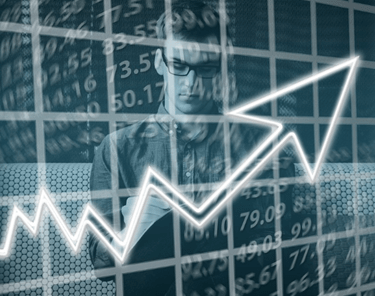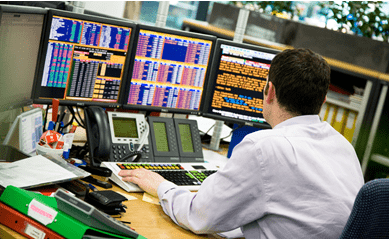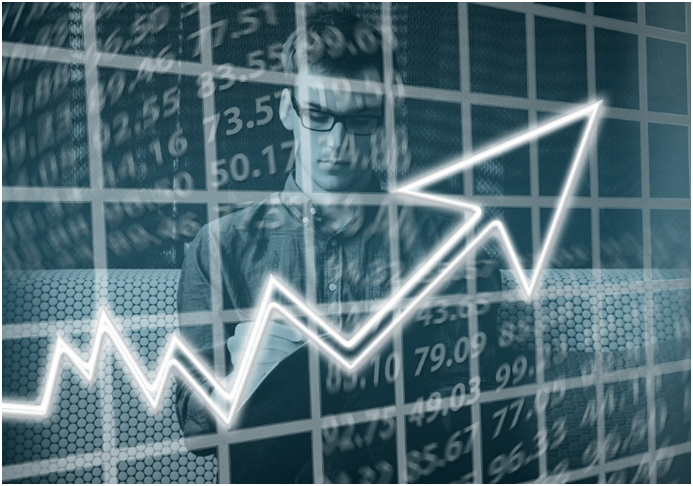What Is Algorithmic Trading? (Stock Algorithms & Investment Algorithms)
What is algorithmic trading? Once upon a time, investing and trading were about financial analysis, individual expertise, and a fair amount of luck. Now, algorithmic trader technology has revolutionized how trading takes place.
Algorithmic trading computers characterized by trading algorithms and high frequency trading algorithms have dramatically changed the game.
An algorithm is a set of rules or operations to be carried out in order to perform a specific function.
They are an important feature of mathematics, particularly computer science. It is no surprise then that the markets have found a way to use algorithms to their advantage by developing stock trading algorithms and algorithmic traders to improve market efficiency.
These stock market algorithms and investment algorithms have played a role in replacing veteran traders.



Image Source: Pixabay.com
The traditional storyline going from how investors bought and sold securities to the current prevalence of high frequency trading algorithms starts with the use of traditional analysis methods in which buyers investigated a company’s health to determine the correct price for a security so they could buy and sell accordingly.
This gave way to Modern Portfolio Theory, which came about as a result of famed economist Harry Markowitz’s application of mathematics to the stock market.
As a result, Markowitz’s game-changing development of a mathematical framework for understanding the stock market was in its own way a form of algorithmic trading, if not at the highly computerized level it exists at today. Markowitz worked on coming up with trading algorithms that helped investors build the optimal investment portfolio.
Naturally, investment houses began to wonder whether these investment algorithms backed by advances in computing technology could determine whether a security was overvalued or undervalued. Such knowledge would be enormously powerful for funds and investment firms and led to the development of advanced stock algorithms.
See Also: Top Long Term Investments – Detailed Overview
Algorithmic Trading and the Development of High Frequency Trading Algorithms
Building on previous work in the field, algorithmic trading had to be developed that allowed computers to act upon useful information immediately. Of course, this meant that firms were eager to develop trading algorithms of their own, instead of using the same stock algorithms of their competitors.
Current high frequency trading algorithms emphasize speed. A split second differentiates one firm’s algorithmic trading from another. This development of stock algorithms into a much more rapid monster is referred to as nanotrading.
Nowadays, nanotrading and stock trading algorithms account for a large volume of trades. Math whizzes that can develop stock market algorithms that can execute trades faster than the competition – even by a fraction of a second – and command an edge in particular markets, are a hot commodity.
Don’t Miss: Investment Advisor Search – Top Investment Companies
The Basics of Algorithmic Trading (Pros & Cons of Trading Algorithms & High Frequency Trading Algorithms)
An algorithm is a very clear-cut set of instructions. Think of it as a mathematical recipe, but with no room for creative license. It follows then that a stock market algorithm or stock trading algorithm is a set of specific instructions for carrying out trades. Stock algorithms are used to carry out rapid trades that would be impossible for a human to execute. The ability of an algorithmic trader to carry out such trades at an inhuman speed makes it possible to realize tremendous profits.
The Pros of Algorithmic Trading
Another pesky feature of the stock market that is addressed by algorithmic trading (and that is considered a pro) is the elimination of emotion. An algorithmic trader does not make emotion or fear-based decisions.
One of the irritating features of the stock market is the tendency for investors to act irrationally. Price fluctuations that will remedy themselves or be insignificant in the long run are met with market panic as people rush to sell their shares, oftentimes at a price lower+ than what they bought them for, an irrational behavior that trading algorithms obviously don’t engage in.
Conversely, investors also tend to exhibit exuberant behavior by jumping on the bandwagon and buying shares for more than they are worth when there is buzz around a particular company. Trading algorithms experience neither panic nor exuberance – in this case, their dispassion is their virtue. Algorithmic trading is a pro in this regard.
All-in-One Change Management Tools
Top Rated Toolkit for Change Managers.
Get Your Change Management Tool Today...
Understanding Algorithmic Trading: Trading Algorithms Examples
As Investopedia outlines while demonstrating basic trading algorithms examples, suppose a trader wanted to buy or sell certain stocks whenever certain conditions were met.
A trader may want to sell a certain number of shares whenever the 50-day moving average goes above the 200-day moving average or sell shares when the 50-day moving average goes below the 200-day moving average.



Image Source: BigStock
If a trading algorithm is written for these conditions, the trader is not required to do any monitoring. The algorithmic trading system will execute this trade whenever these simple conditions are met, allowing the trader to quickly act upon information without being there to notice it.
Additionally, ideal circumstances can change quickly. Algorithmic trading methods allow for near-instantaneous executions that allow a trader or traders to benefit from the specific market conditions they were waiting for.
The trading algorithms can help carry out the trade at the desired market price. There are definitely pros to stock market algorithms.
One of the pros is the accuracy of the trade carried out by trading algorithms. Moreover, they avoid price changes in the market thanks to their rapidity. Algorithmic trading minimizes the risk of manual or human error during trade executions.
The algorithmic trader can also run a comparison against several other market conditions.
Additionally, investment algorithms can be backtested against historical data. This is a particularly useful feature since the effectiveness of a given stock trading algorithm can be verified by demonstrating how useful it would have been for prior time periods in the market.
And as mentioned, you do not have to worry about emotional or psychological influences on trades with stock algorithms.
Related: Best Asset Management Firms | Best Asset Managers
What Is a High Frequency Trading Algorithm?
High frequency trading algorithms facilitate a particular trading strategy. These trading algorithms carry out extremely rapid orders in a number of markets under several pre-programmed conditions in an effort to realize the most profit.
Those with the technology and the algorithmic trader that can carry out orders the fastest, reap the most rewards.
The high frequency trading algorithms that these computers use are exceptionally complex, and these high frequency algorithmic traders are very powerful machines. The percentage of exchange volume carried out by high frequency trading and its trading algorithms increases every year.
Cons of Algorithmic Trading and High Frequency Trading
With all the perks that come with algorithmic trading, there are definitely downsides that observers have been quick to point out. While trading algorithms and high frequency trading algorithms help alleviate a number of market problems, they can also cause snafus as well.
One obvious concern is the potential for computer failures. Algorithmic trading is carried out on computers, after all, and computers, for all their celebrated precision, are not infallible. One of the suggested causes of the 2010 Flash Crash is a number of technical glitches in the algorithmic traders; although this is certainly not the only cause, rather, it is believed to be a contributing factor.
Trading algorithms and the machines that run them may also be inconsistent in the beginning when it comes to transitioning from theoretical trades to real trades.
Additionally, depending on the algorithmic trader being used, the data for a specific trade could be stored on a computer as opposed to a server, which means an order may not go to market if there is a loss of Internet connectivity.
The other con of algorithmic trading is an extension of the possibility of mechanical failures. While you can technically leave an algorithmic trader and set it so that it can carry out specific trades under certain conditions, there is still a minimal amount of supervision needed in case of mechanical failures or loss of power or connectivity.
A stock market algorithm can carry out trades on your behalf, but if the computer powering that stock trading algorithm is offline, it becomes vital that a human is monitoring the system.
Another potential issue that is not specific to algorithmic trading is over-optimization. Backtesting allows developers to test a trading algorithm’s performance and value against historical data. While this can be great for verifying the value and usefulness of stock trading algorithms, it can also lead to a situation where investment algorithms are stellar in theory, but not in practice.
Popular Article: eToro Review –Review and Ranking (eToro Fees, App, Trading, Account and Services)



How High Frequency Trading Algorithms Assist Market Makers
A market maker holds a large number of securities with the intention of being the go-to buyer and seller, at specific prices. On the one hand, this keeps the markets liquid and the market maker turns a profit by selling at one price and buying at another. High frequency trading algorithms allow traders to do this with large volumes and with the flexibility of responding to market behavior.
As Bloomberg News explains it, a market maker will offer to buy 100 shares of Stock
A for $9.99 and then sells those shares for $10.01. If they manage to sell a share for $10.01, they have now realized a profit of 2 cents for just being the go-between. Determining the price is one crucial step that an algorithmic trading assists the trader with.
Using their algorithmic trader, a trader can place a bid to buy 100 shares for $9.99 and simultaneously put up the sale of $10.01. The price then changes depending on how the buying and selling plays out.
If a trader comes along and buys 100 shares of stock A for $10.01, they can raise the prices to $10.00 and $10.02 for their buying and selling, respectively. Alternatively, if a trader sells 100 shares to this market maker for $9.99, the price will go to $9.98 and $10.00.
Essentially, a penny up whenever there is a purchase and a penny down whenever someone sells.
Naturally, this means that the high frequency trading algorithm is carrying out and cancelling a huge volume of orders. This algorithmic trading by market makers is further complicated by their involvement on a number of different exchanges, which is necessary if they want to be a real market maker.
High frequency trading algorithms allow market makers to respond quickly to supply and demand and change their prices accordingly.
Great for the market maker — not so much for traders who find prices changing rapidly, since the algorithmic trader can adjust the prices faster than new traders can buy at those prices.
In some cases, high frequency trading algorithms can be used to “spoof” the market by creating fake demand through suspicious order cancellations. This allows them to benefit by meeting that demand, but it can have a chaotic effect on the markets.
Algorithmic trading, particularly high frequency trading algorithms, has attracted much attention from financial analysts, journalists, and politicians.
While algorithmic traders have led to efficiencies and large profits for some, their potential misuse and the havoc they can wreak on the markets have led to calls for updated stock market algorithm regulation and legislation to address these new technologies in the stock market.
Read More: What Is a Timeshare? Overview of Buying and Selling Timeshares
AdvisoryHQ (AHQ) Disclaimer:
Reasonable efforts have been made by AdvisoryHQ to present accurate information, however all info is presented without warranty. Review AdvisoryHQ’s Terms for details. Also review each firm’s site for the most updated data, rates and info.
Note: Firms and products, including the one(s) reviewed above, may be AdvisoryHQ's affiliates. Click to view AdvisoryHQ's advertiser disclosures.





